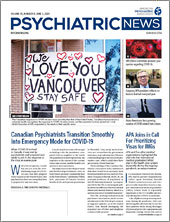In their presentation at APA’s virtual Spring Highlights meeting in April, Kimberly Williams, president and CEO of Vibrant Emotional Health, and two of her colleagues at Vibrant explained why crisis hotlines are key to transforming the delivery of mental health care, a topic made all the more relevant, Williams pointed out, due to the COVID-19 pandemic.
“Crisis hotlines are a core part of our nation’s mental health safety net, particularly at a time like this,” Williams said. Vibrant provides 24/7 crisis hotline services, often in partnership with local, state, and federal governments, as well as the private sector.
In 2018, 2.3 million people called into Vibrant’s National Suicide Prevention Lifeline, and Vibrant projects that the Lifeline will receive almost 2.9 million calls in 2020. The Lifeline relies on a national network of crisis call centers. Vibrant also offers text and online crisis services.
The Federal Communications Commission has recommended that 988 become the new three-digit, nationwide number for people experiencing mental health or suicidal crisis (see
Psychiatric News). If the number is implemented, it will be a game changer in terms of increasing people’s access to care and reducing the stigma of mental illness, John Draper, Ph.D., Vibrant’s executive vice president of national networks, said.
“Today we are now seeing, with people isolated in their homes, that the kinds of services that crisis hotlines can provide are absolutely essential,” Draper said.
Due to the COVID-19 pandemic, calls have increased to Vibrant’s Disaster Distress Helpline. Usually it receives about 50 calls a day, but recently it has been receiving upward of 600.
Vibrant’s NYC Well—the support, crisis intervention, and information and referral service for people living in New York City—launched in late 2016, said program director Kelly Clarke. In 2017, 300,000 people reached out to NYC Well through phone calls, texts, and online chats. In 2019, that number rose to 350,000. “And we’re on track for more growth again in 2020,” Clarke said. NYC Well has also seen a surge in calls due to the COVID-19 pandemic.
Draper explained that Vibrant established national standards for risk assessment with four core principles: assessing the caller’s desire to die by suicide, their intent, their capability to die by suicide, and the buffers that may prevent them from following through.
For callers at imminent risk, the crisis centers follow additional protocols that involve actively engaging these callers in the least invasive way possible, implementing active rescue through emergency services agencies, and collaborating with those agencies.
“The evidence shows we are effective,” Draper said. Lifeline’s policies for reducing imminent risk have been shown to enhance crisis centers’ ability to collaboratively de-escalate people at the highest risk for suicide without having to use involuntary or rescue services.
“And our follow up calls have been shown to save lives,” Draper said. “Eighty percent [of callers] said these calls helped keep them alive, with half of them saying it’s the reason they are alive.” ■
